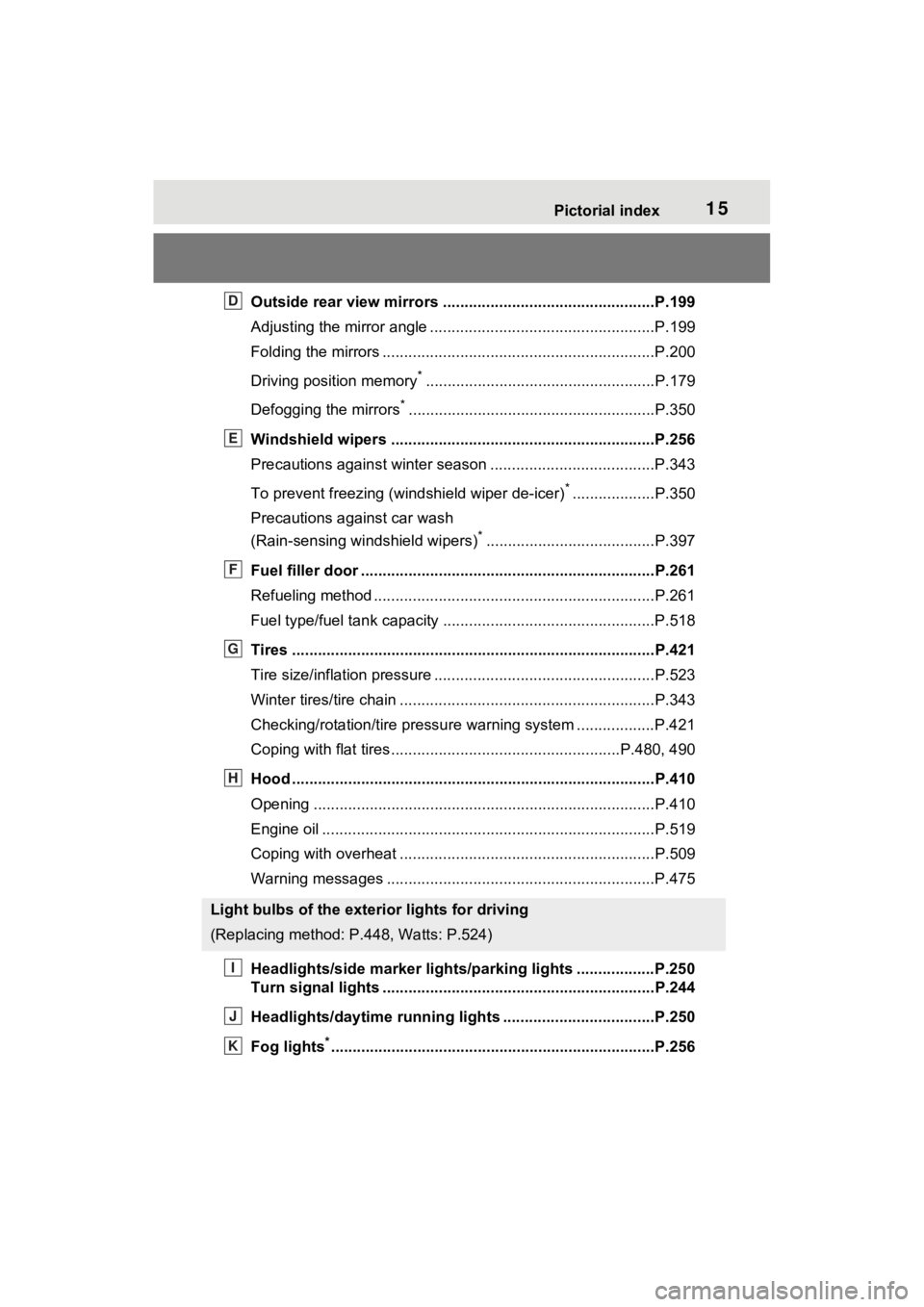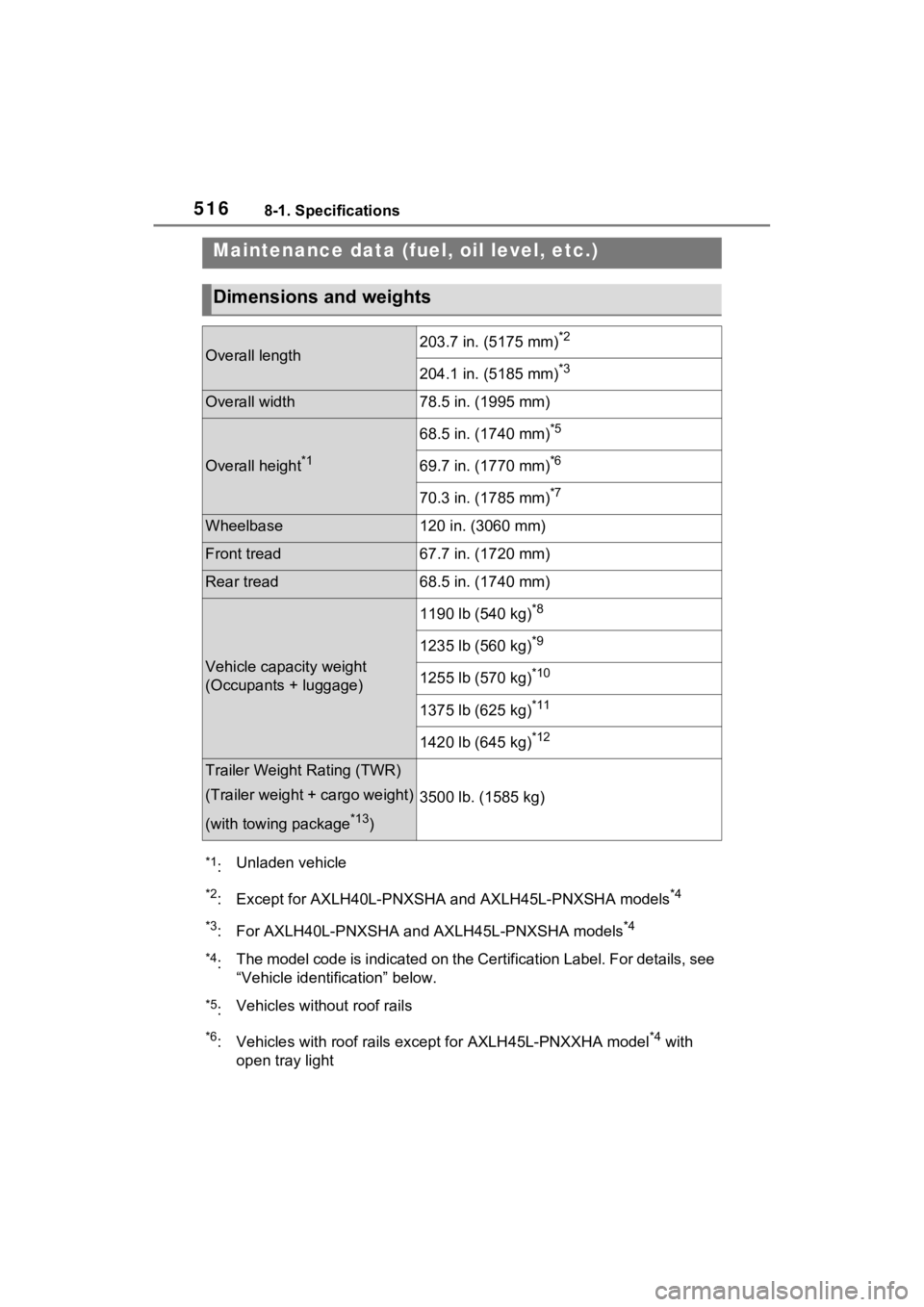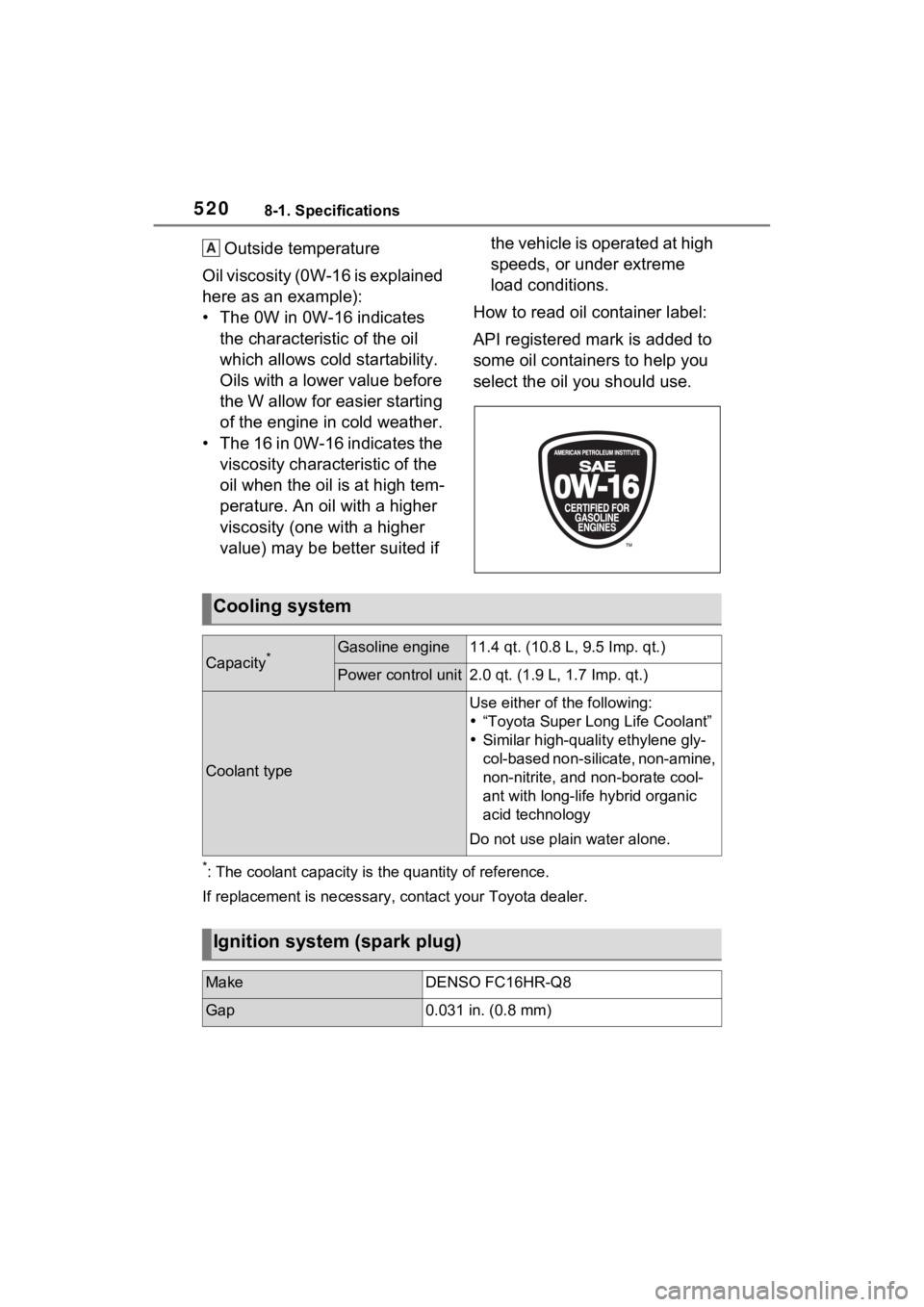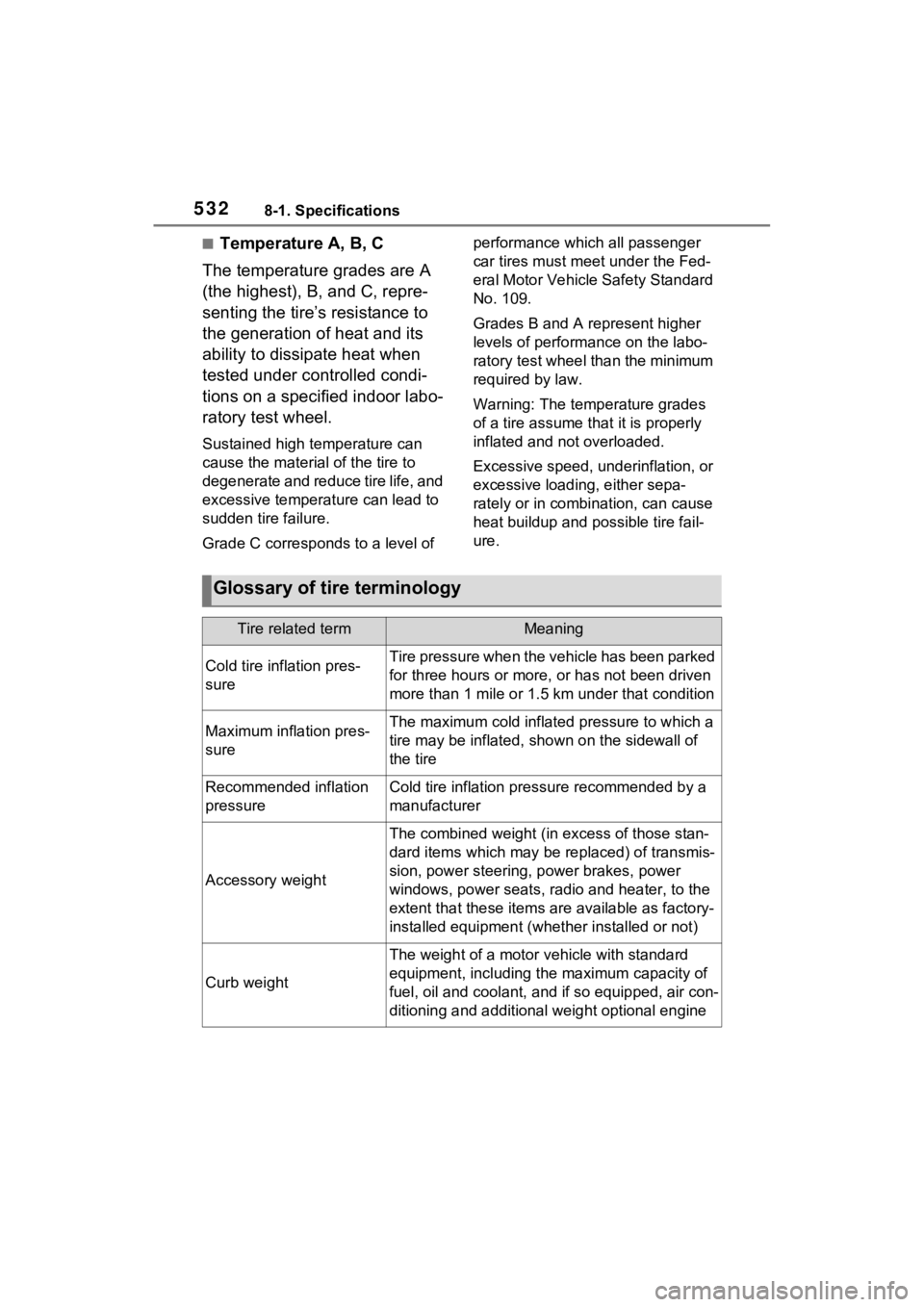2022 TOYOTA SIENNA HYBRID oil capacity
[x] Cancel search: oil capacityPage 15 of 600

15Pictorial index
Outside rear view mirrors .................................................P.199
Adjusting the mirror angle ....................................................P.199
Folding the mirrors ...............................................................P.200
Driving position memory
*.....................................................P.179
Defogging the mirrors
*.........................................................P.350
Windshield wipers .............................................. ...............P.256
Precautions against winter season .............................. ........P.343
To prevent freezing (windshield wiper de-icer)
*...................P.350
Precautions against car wash
(Rain-sensing windshield wipers)
*.......................................P.397
Fuel filler door ............................................... .....................P.261
Refueling method ............................................... ..................P.261
Fuel type/fuel tan k capacity .................................................P.518
Tires ....................................................................................P.421
Tire size/inflation pressure ................................... ................P.523
Winter tires/tire chain ........................................ ...................P.343
Checking/rotation/tire pressur e warning system ..................P.421
Coping with flat tires......................................... ............P.480, 490
Hood ....................................................................................P.410
Opening ........................................................ .......................P.410
Engine oil ..................................................... ........................P.519
Coping with overheat ........................................... ................P.509
Warning messages ..............................................................P.475
Headlights/side marke r lights/parking lights ..................P.250
Turn signal lights ...............................................................P.244
Headlights/daytime running lights .............................. .....P.250
Fog lights
*............................................................... ............P.256
Light bulbs of the exterior lights for driving
(Replacing method: P.448, Watts: P.524)
D
E
F
G
H
I
J
K
Page 17 of 600

17Pictorial index
Opening/closing the rear side windows ...............................P.202
Warning messages ..............................................................P.475
Back door ...................................................... .....................P.150
Locking/unlocking ................................................................P.151
Opening from inside the cabin
*............................................P.154
Opening from outside........................................... ........P.152, 153
Warning messages ..............................................................P.475
Outside rear view mirrors .................................................P.199
Adjusting the mirror angle ..................................... ...............P.199
Folding the mirrors ...............................................................P.200
Driving position memory
*.....................................................P.179
Defogging the mirrors
*.........................................................P.350
Windshield wipers .............................................. ...............P.256
Precautions against winter season .............................. ........P.343
To prevent freezing (windshield wiper de-icer)
*...................P.350
Precautions against car wash
(Rain-sensing windshield wipers)
*.......................................P.397
Fuel filler door ............................................... .....................P.261
Refueling method ............................................... ..................P.261
Fuel type/fuel tan k capacity .................................................P.518
Tires ....................................................................................P.421
Tire size/inflation pressure ................................... ................P.523
Winter tires/tire chain ........................................ ...................P.343
Checking/rotation/tire pressur e warning system ..................P.421
Coping with flat tires......................................... ............P.480, 490
Hood ....................................................................................P.410
Opening ........................................................ .......................P.410
Engine oil ..................................................... ........................P.519
Coping with overheat ........................................... ................P.509
Warning messages ..............................................................P.475
C
D
E
F
G
H
Page 437 of 600

4376-3. Do-it-yourself maintenance
6
Maintenance and care
When replacing wheels, care
should be taken to ensure that
they are equivalent to those
removed in load capacity, diam-
eter, rim width and inset
*.
Replacement wheels are avail-
able at your Toyota dealer.
*: Conventionally referred to as off- set.
Toyota does not recommend
using the following:
Wheels of different sizes or
types
Used wheels
Bent wheels that have been
straightened
■When replacing wheels
The wheels of your vehicle are
equipped with tire pressure warning
valves and transmitters that allow
the tire pressure warning system to
provide advance warning in the
event of a loss in tire inflation pres-
sure. Whenever wheels are
replaced, tire pressure warning
valves and transmitters must be
installed. ( P.424, 438)
Wheels
If a wheel is bent, cracked or
heavily corroded, it should
be replaced. Otherwise, the
tire may separate from the
wheel or cause a loss of
handling control.
Wheel selection
WARNING
■When replacing wheels
●Do not use wheels that are a dif-
ferent size from those recom-
mended in the Owner’s Manual,
as this may result in a loss of
handling control.
●Never use an inner tube in a
leaking wheel which is designed
for a tubeless tire. Doing so may
result in an accident, causing
death or serious injury.
■When installing the wheel
nuts
Never use oil or grease on the
wheel bolts or wheel nuts. Oil and
grease may cause the wheel nuts
to be excessively tightened, lead-
ing to bolt or disc wheel damage.
In addition, the oil or grease can
cause the wheel nuts to loosen
and the wheel may fall off, caus-
ing an accident and resulting in
death or serious injury. Remove
any oil or grease from the wheel
bolts or wheel nuts.
■Use of defective wheels pro-
hibited
Do not use cracke d or deformed
wheels.
Doing so could cause the tire to
leak air during driving, possibly
causing an accident.
Page 516 of 600

5168-1. Specifications
8-1.Specifications
Maintenance data (fuel, oil level, etc.)
Dimensions and weights
Overall length203.7 in. (5175 mm)*2
204.1 in. (5185 mm)*3
Overall width78.5 in. (1995 mm)
Overall height*1
68.5 in. (1740 mm)*5
69.7 in. (1770 mm)*6
70.3 in. (1785 mm)*7
Wheelbase120 in. (3060 mm)
Front tread67.7 in. (1720 mm)
Rear tread68.5 in. (1740 mm)
Vehicle capacity weight
(Occupants + luggage)
1190 lb (540 kg)*8
1235 lb (560 kg)*9
1255 lb (570 kg)*10
1375 lb (625 kg)*11
1420 lb (645 kg)*12
Trailer Weight Rating (TWR)
(Trailer weight + cargo weight)
(with towing package
*13)
3500 lb. (1585 kg)
*1:Unladen vehicle
*2:Except for AXLH40L-PNXSHA and AXLH45L-PNXSHA models*4
*3:For AXLH40L-PNXSHA and AXLH45L-PNXSHA models*4
*4:The model code is indicated on the Certification Label. For det ails, see
“Vehicle identification” below.
*5:Vehicles without roof rails
*6:Vehicles with roof rails e xcept for AXLH45L-PNXXHA model*4 with
open tray light
Page 519 of 600

5198-1. Specifications
8
Vehicle specifications
Rear (AWD models)
■Oil capacity (Drain and refill
reference
*)
*: The engine oil capacity is a refer-
ence quantity to be used when
changing the engine oil. Warm up
the engine and turn off the hybrid
system, wait more than 5 min-
utes, and check the oil level on
the dipstick.
■Engine oil selection
“Toyota Genuine Motor Oil” is
used in your Toyota vehicle.
Use Toyota approved “Toyota
Genuine Motor Oil” or equiva-
lent to satisfy the following
grade and viscosity.
Oil grade: ILSAC GF-6B multigrade engine
oil
Recommended viscosity:
SAE 0W-16
SAE 0W-16 is the best choice
for good fuel economy and good
starting in cold weather.
If SAE 0W-16 is not available,
SAE 0W-20 oil may be used.
However, it must be replaced
with SAE 0W-16 at the next oil
change.
TypePermanent magnet synchronous motor
Maximum output40 kW
Maximum torque89.2 ft•lbf (121 N•m, 12.3 kgf•m)
Hybrid battery (traction battery)
TypeNickel-Metal hy
dride battery
Voltage7.2 V/module
Capacity6.5 Ah (3HR)
Quantity40 modules
Nominal voltage288 V
Lubrication system
With filter4.8 qt. (4.5 L, 4.0 Imp.
qt.)
Without fil-
ter4.4 qt. (4.2 L, 3.7 Imp.
qt.)
Page 520 of 600

5208-1. Specifications
Outside temperature
Oil viscosity (0W-16 is explained
here as an example):
• The 0W in 0W-16 indicates the characteristic of the oil
which allows cold startability.
Oils with a lower value before
the W allow for easier starting
of the engine in cold weather.
• The 16 in 0W-16 indicates the viscosity characteristic of the
oil when the oil is at high tem-
perature. An oil with a higher
viscosity (one with a higher
value) may be better suited if the vehicle is operated at high
speeds, or under extreme
load conditions.
How to read oil container label:
API registered mark is added to
some oil containers to help you
select the oil you should use.
*: The coolant capacity is the quantity of reference.
If replacement is ne cessary, contact your Toyota dealer.
A
Cooling system
Capacity*Gasoline engine11.4 qt. (10.8 L, 9.5 Imp. qt.)
Power control unit2.0 qt. (1.9 L, 1.7 Imp. qt.)
Coolant type
Use either of the following:
“Toyota Super Long Life Coolant”
Similar high-quality ethylene gly-
col-based non-silicate, non-amine,
non-nitrite, and non-borate cool-
ant with long-life hybrid organic
acid technology
Do not use plain water alone.
Ignition system (spark plug)
MakeDENSO FC16HR-Q8
Gap0.031 in. (0.8 mm)
Page 532 of 600

5328-1. Specifications
■Temperature A, B, C
The temperature grades are A
(the highest), B, and C, repre-
senting the tire’s resistance to
the generation of heat and its
ability to dissipate heat when
tested under controlled condi-
tions on a specified indoor labo-
ratory test wheel.
Sustained high temperature can
cause the material of the tire to
degenerate and reduce tire life, and
excessive temperature can lead to
sudden tire failure.
Grade C corresponds to a level of performance which all passenger
car tires must meet under the Fed-
eral Motor Vehicle Safety Standard
No. 109.
Grades B and A represent higher
levels of performance on the labo-
ratory test wheel than the minimum
required by law.
Warning: The temperature grades
of a tire assume tha
t it is properly
inflated and not overloaded.
Excessive speed, underinflation, or
excessive loading, either sepa-
rately or in combination, can cause
heat buildup and possible tire fail-
ure.
Glossary of tire terminology
Tire related termMeaning
Cold tire inflation pres-
sureTire pressure when the vehicle has been parked
for three hours or more, or has not been driven
more than 1 mile or 1.5 km under that condition
Maximum inflation pres-
sureThe maximum cold inflated pressure to which a
tire may be inflated, shown on the sidewall of
the tire
Recommended inflation
pressureCold tire inflation pressure recommended by a
manufacturer
Accessory weight
The combined weight (in excess of those stan-
dard items which may be replaced) of transmis-
sion, power steering, power brakes, power
windows, power seats, radio and heater, to the
extent that these items are available as factory-
installed equipment (whether installed or not)
Curb weight
The weight of a motor vehicle with standard
equipment, including th e maximum capacity of
fuel, oil and coolant, and if so equipped, air con-
ditioning and additional weight optional engine
Page 572 of 600

572Alphabetical Index
Power easy access system .. 179
Driving support system informa- tion display ........................... 110
Dynamic radar cruise control with full-speed rangeFunction ............................... 290
Warning message ................ 475
E
ECB (Electronically Controlled Brake System) ...................... 334
Eco drive mode ...................... 333
EDR (Event data recorder)......... 8
E-Four (Electronic On-Demand AWD system) ........................ 335
Elapsed time ........................... 111
Electric motor Location.................................. 79
Specification ......................... 518
Electric Power Steering (EPS) Function ............................... 335
Warning light ........................ 466
Electronically Controlled Brake System (ECB) ....................... 334
Electronic key Battery-saving function......... 166
If the electronic key does not operate properly ................. 502
Replacing the battery ........... 444
Emergency, in case of If a warning buzzer sounds .. 464
If a warning light turns on ..... 464
If a warning message is dis-played................................. 475
If the 12-volt battery is dis- charged .............................. 504
If the electronic key does not operate properly ................. 502
If the fuel filler door cannot be opened ............................... 501
If the hybrid sy stem will not start
........................................... 499 If the vehicle is submerged or
water on the road is rising ..458
If you have a flat tire .....480, 490
If you lose your keys.............500
If you think something is wrong ...........................................463
If your vehicle becomes stuck ...........................................513
If your vehicle has to be stopped in an emergency .................457
If your vehicle needs to be towed ...........................................460
If your vehicle ove rheats ......509
Emergency flashers ...............456
Energy monitor .......................122
Engine Compartment........................413
Hood .....................................410
Identification number ............518
Engine coolant Capacity ...............................520
Checking ..............................416
Preparing and checking before winter ..................................343
Warning light ........................465
Engine coolant temperature gauge ...............................97, 101
Engine oil Capacity ...............................519
Checking ..............................413
Preparing and checking before winter ..................................343
Warning light ........................465
Engine oil maintenance data .415
Enhanced Vehicle Stability Con- trol (Enhanced VSC ) .............335
Enhanced VSC (Enhanced Vehi- cle Stability Control).............335
EPS (Electric Po wer Steering)
Function................................335
Warning light ........................466
EV drive mode.........................238